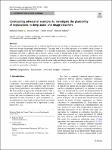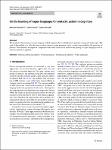Search
Author
- Ackerman, Gary L (1)
- Adrián, Sánchez-Caballero (1)
- Ahmad, Karim (1)
- Ahmed, Eldawy (1)
- next >
Subject
- 2N labeling defense me... (1)
- A primal-dual splittin... (1)
- algorithmic judges (1)
- ANFIS (1)
- next >
Has File(s)
- true (39)
Search Results
The fast improvement of deep learning methods resulted in breakthroughs in image classification, however, these models are sensitive to adversarial perturbations, which can cause serious problems. Adversarial attacks try to change the model output by adding noise to the input, in our research we propose a combined defense method against it. Two defense approaches have been evolved in the literature, one robustizes the attacked model for higher accuracy, and the other approach detects the adversarial examples. Only very few papers discuss both approaches, thus our aim was to combine them to obtain a more robust model and to examine the combination, in particular the filtering capability of the detector. Our contribution was that the filtering based on the decision of the detector is ... |
Remote Healthcare Monitoring Systems (RHMs) that employ fetal phonocardiography (fPCG) signals are highly efficient technologies for monitoring continuous and long-term fetal heart rate. Wearable devices used in RHMs still face a challenge that decreases their efficacy in terms of energy consumption because these devices have limited storage and are powered by batteries. This paper proposes an effective fPCG compression algorithm to reduce RHM energy consumption. In the proposed algorithm, the Discrete Orthogonal Charlier Moment (DOCMs) is used to extract features of the signal. The householder orthonormalization method (HOM) is used with the Charlier Moment to overcome the propagation of numerical errors that occur when computing high-order Charlier polynomials. |
While the evolution of mobile computing is experiencing considerable growth, it is at the same time seriously threatened by the limitations of battery technology, which does not keep pace with the evergrowing increase in energy requirements of mobile applications. Yet, with the limits of human perception and the diversity of requirements that individuals may have, a question arises of whether the effort should be made to always deliver the highest quality result to a mobile user? In this work we investigate how a user’s physical activity, the spatial/temporal properties of the video, and the user’s personality traits interact and jointly influence the minimal acceptable playback resolution. We conduct two studies with 45 participants in total and find out that the minimal acceptable... |
Given the rise of deep learning and its inherent black-box nature, the desire to interpret these systems and explain their behaviour became increasingly more prominent. The main idea of so-called explainers is to identify which features of particular samples have the most influence on a classifier’s prediction, and present them as explanations. Evaluating explainers, however, is difficult, due to reasons such as a lack of ground truth. In this work, we construct adversarial examples to check the plausibility of explanations, perturbing input deliberately to change a classifier’s prediction. This allows us to investigate whether explainers are able to detect these perturbed regions as the parts of an input that strongly influence a particular classification. Our results from the audi... |
We consider a generic type of nonlinear Hammerstein-type integral equations with the particularity of having non-differentiable kernel of Nemystkii type. So, in order to solve it we consider a uniparametric family of iterative processes derivative free, with the main advantage that for a special value of the involved parameter the iterative method obtained coincides with Newton’s method, that is due to the fact of evaluating the divided difference operator when the two values are the same. We perform a qualitative convergence study by choosing an auxiliary point, that allow us to obtain the existence and separation of solutions of the given equation, that is, local and semilocal convergence balls can be obtained. |
This work proposes and compare two different approaches for real-time human action recognition (HAR) from raw depth video sequences. Both proposals are based on the convolutional long short-term memory unit, namely ConvLSTM, with differences in the architecture and the long-term learning. The former uses a video-length adaptive input data generator (stateless) whereas the latter explores the stateful ability of general recurrent neural networks but is applied in the particular case of HAR. This stateful property allows the model to accumulate discriminative patterns from previous frames without compromising computer memory. Furthermore, since the proposal uses only depth information, HAR is carried out preserving the privacy of people in the scene, since their identities can not be ... |
The method of the learning of vague languages which represent distorted/ambiguous patterns is proposed in the paper. The goal of the method is to infer the quasi-context-sensitive string grammar which is used in our model as the generator of patterns. The method is an important component of the multi-derivational model of the parsing of vague languages used for syntactic pattern recognition. |
Some of the most critical competencies students need to acquire to become control engineers require performing practices under actual industrial conditions. This means that they must not only master the theoretical aspects of the discipline but also acquire skills and attitudes to face unpredictable real-world situations. Software tools such as Matlab/Simulink are widely used to train the design and validation of controllers, but they fail to provide real industrial contexts. Nowadays, there are 3D simulation tools that support recreating industrial environments to a remarkable extent, making them very attractive for university courses. Nevertheless, their application in engineering courses is scarce yet. This paper presents a methodological framework for seizing into competency-bas... |
A single network model can’t extract more complex and rich effective features. Meanwhile, the network structure is usually huge, and there are many parameters and consume more space resources, etc. Therefore, the combination of multiple network models to extract complementary features has attracted extensive attention. In order to solve the problems existing in the prior art that the network model can’t extract high spatial depth features, redundant network structure parameters, and weak generalization ability, this paper adopts two models of Xception module and inverted residual structure to build the neural network. Based on this, a face expression recognition method based on improved depthwise separable convolutional network is proposed in the paper. Firstly, Gaussian filtering i... |









